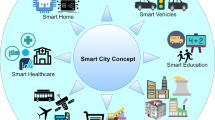Abstract
As pervasive computing is developed, a user's context information will be used in a system to provide the user with intelligent services. Context is defined as information that characterizes the situation of an entity under a certain system environment. In this paper, we classify the context in a system into three types: user context, device context, and proximity context, which is the context information between a user and device. We designed HIML (Human Interaction Markup Language) to express the proposed contexts, and the middleware performed on various platforms, including a NUI/NUX (Natural User Interface/Natural User eXperience) platform, and interacted between appliances and sensors using HIML. We demonstrated its functions through experiments.









Similar content being viewed by others
References
Augusto JC, Callaghan V, Cook D, Kameas A, Satoh I (2013) Intelligent environments: a manifesto. Human-centric Computing and Information Sciences 3(1):1–18. doi:10.1186/2192-1962-3-12
Dey AK, Abowd GD (1999) Towards a better understanding of context and context-awareness. Technical Report GIT-GVU-99-22, Georgia Institute of Technology College of Computing.
DEY AK, Abowd GD, Salber D (2001) A conceptual framework and a toolkit for supporting the rapid prototyping of context-aware applications. Hum Comput Interact 16(2):97–166. doi:10.1207/S15327051HCI16234_02
Dubey T, Sahu OP (2013) Self-localized packet forwarding in wireless sensor networks. Journal of Information Processing Systems 9(3):477–488. doi:10.3745/JIPS.2013.9.3.477
Hong S, Chang J (2013) A new k-NN query processing algorithm based on multicasting-based cell expansion in location-based services. Journal of Convergence 4(4):1–6
Hong JI, Landay JA (2001) An infrastructure approach to context-aware computing. Hum Comput Interact 16(2):287–303. doi:10.1207/S15327051HCI16234_11
Korpipaa P, Mantyjarvi J, Kela J, Keranen H, Malm EJ (2003) Managing context information in mobile devices. IEEE pervasive computing 2(3):42–51. doi:10.1109/MPRV.2003.1228526
Lee H, Chung K, Jhang K (2013) A study of wireless sensor network routing protocols for maintenance access hatch condition surveillance. Journal of Information Processing Systems 9:237–246. doi:10.3745/JIPS.2013.9.2.237
Lee G, Shin D, Shin D (2013) An implementation of intuitive NUI/NUX conversion framework using kinect and XML. Proceedings of the FTRA 2013 International Symposium on Ubiquitous Computing and Embedded Systems 160–164
Luo Y, Hoeber O, Chen Y (2013) Enhancing Wi-Fi fingerprinting for indoor positioning using human-centric collaborative feedback. Human-centric Computing and Information Sciences 3(1):1–23. doi:10.1186/2192-1962-3-2
McNaull J, Augusto JC, Mulvenna M, McCullagh P (2014) Flexible context aware interface for ambient assisted living. Human-centric Computing and Information Sciences 4(1):1. doi:10.1186/2192-1962-4-1
Ng CK, Ee GK, Noordin NK (2013) Finger triggered virtual musical instruments. Journal of Convergence 4(1):39–46
Peng K (2013) A secure network for mobile wireless service. Journal of Information Processing Systems 9(2):247–258. doi:10.3745/JIPS.2013.9.2.247
Rose B (2001) Home networks: a standards perspective. IEEE Commun Mag 39(12):78–85. doi:10.1109/35.968816
Shafer SAN, Brumitt B, Cadiz JJ (2001) Interaction issues in context-aware intelligent environments. Human-Computer Interaction Journal 16(2):363–378. doi:10.1207/S15327051HCI16234_16
Weiser M (1993) Some computer science issues in ubiquitous computing. Commun ACM 36(7):75–84
Yoon M, Chang J, Kim Y (2013) An energy-efficient routing protocol using message success rate in wireless sensor networks. Journal of Convergence 4(1):15–22
Acknowledgements
This research was supported by the MSIP (Ministry of Science, ICT and Future Planning), Korea, under the ITRC (Information Technology Research Center) support program (NIPA-2013-H0301-13-4007) supervised by the NIPA (National IT Industry Promotion Agency).
Author information
Authors and Affiliations
Corresponding author
Rights and permissions
About this article
Cite this article
Shin, D., Lee, G., Shin, D. et al. System architecture using human interaction markup language for context awareness in home network. Multimed Tools Appl 75, 15199–15209 (2016). https://doi.org/10.1007/s11042-014-2286-6
Received:
Revised:
Accepted:
Published:
Issue Date:
DOI: https://doi.org/10.1007/s11042-014-2286-6




